Rules for processing cucumbers with whey and iodine: recipes and proportions
Despite the abundance of fungicides and insecticides offered in garden centers, many gardeners and gardeners prefer to use proven folk remedies, prepared with their own hands from safe ingredients.
Let's consider the most popular folk remedies for processing cucumbers - compositions based on whey and iodine.
Features of fertilizing and its benefits for plants
Growing cucumbers throughout the growing season accompanied by regular fertilizing and treatment of the crop against diseases and pests.
The use of chemicals for processing vegetables requires compliance with safety precautions and correct calculation of the concentration of substances. Traditional processing methods are safe application and high efficiency.
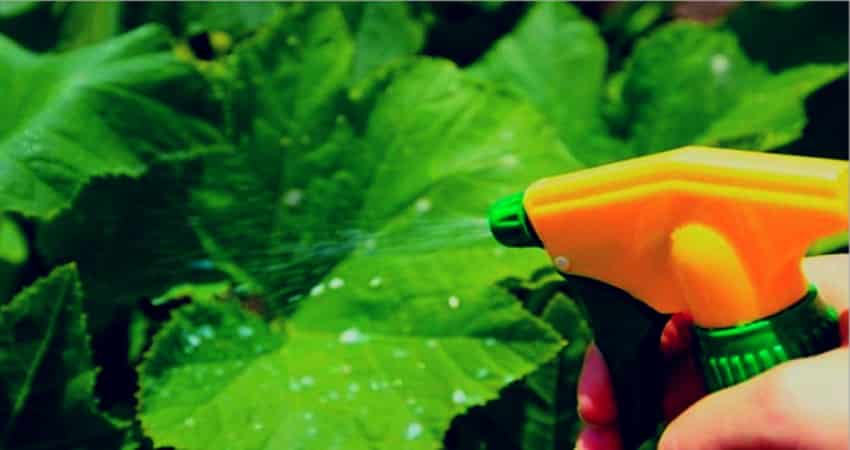
One of the many folk remedies for processing cucumbers is iodine-whey solution.. The lactic acid product contains microelements that compensate for the lack of nutrients in the plant. A solution of serum with the addition of iodine is used to treat many diseases of cucumbers and to control insect pests.
How does the solution work and in what cases is it used?
Whey is a natural antiseptic. The starter microflora included in its composition and the acidic environment of the product actively suppress the growth and development of pathogenic fungi and pathogenic bacteria. The serum is not a chemical substance; its effect on the plant is absolutely safe.Additionally, organic matter nourishes the plant, activates growth, flowering, and fruiting.
To enhance the antiseptic properties, iodine is added to the serum: the resulting mixture actively fights not only fungal, but also bacterial infections.
Iodine is a stimulator of crop growth. Its use promotes abundant flowering and the appearance of ovaries. The specific smell of iodine repels insect pests.
Iodine-whey solution improves the quality of the crop and the nutritional value of cucumbers. The solution is successfully used for the prevention and treatment of late blight.
Reference. Treatment with a whey solution with the addition of iodine begins from the moment shoots emerge until the fruiting period.
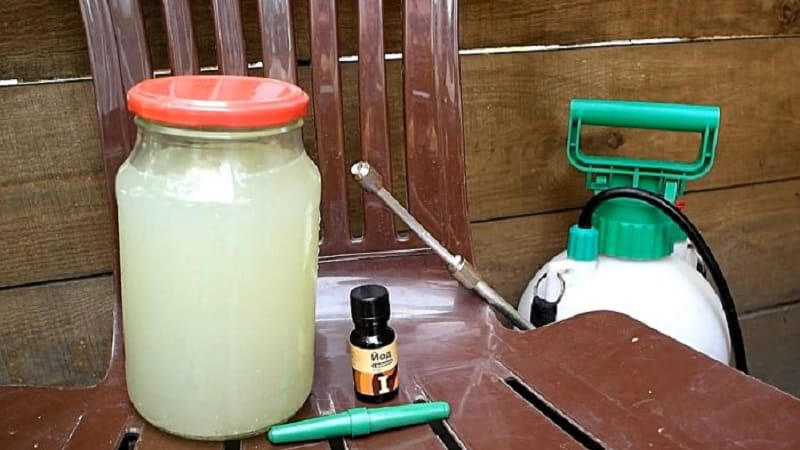
As a fertilizer
Amino acids contained in whey benefit plants.. The product also contains macro- and microelements necessary for growth and fruiting: nitrogen, potassium, phosphorus, calcium, sulfur, iron, zinc.
How to properly feed cucumbers with whey? When using whey as a root feed, keep in mind that this will increase the acidity of the soil. That's why The serum must be diluted with water.
Iodine is necessary for the quality development of the crop. Timely use of this microelement helps:
- accelerating the ripening of cucumbers;
- improving the taste of vegetables;
- increasing the vitamin C content in fruits.
With its deficiency, the fruiting process is inhibited, the ovaries do not develop and rot.
When preparing a nutritious iodine-whey mixture, attention is paid to its concentration. The following proportions are recommended for application to the soil: 1 liter of whey, 3 drops of iodine, 10 liters of water. To spray the leaf mass, make a solution: 1 liter of serum, 1 drop of iodine, 5 liters of water.This solution is used for premature yellowing of leaves on cucumbers.
Reference. Whey is used to speed up the decomposition process of compost.
In pest control
Iodine is an excellent tool in the fight against insect pests. The unpleasant odor characteristic of iodine repels spider mites, aphids, thrips and other small pests from plants.
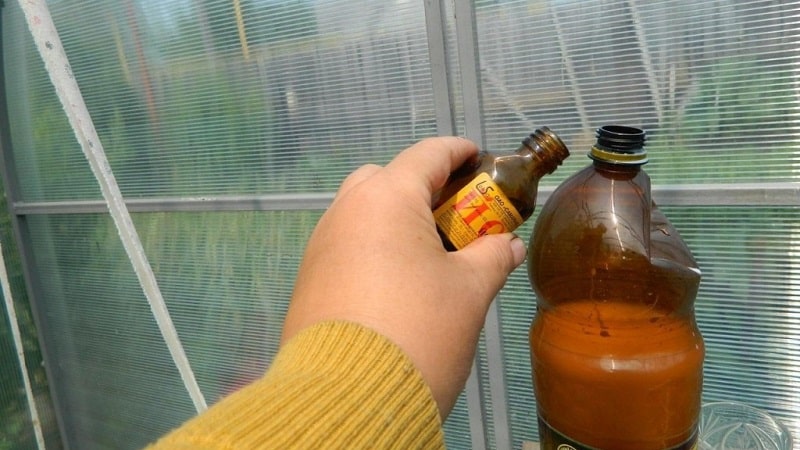
When spraying cucumbers with serum containing iodine, a thin protein protective film. It clogs the respiratory system of pests - insects are deprived of the opportunity to breathe, feed and die.
Interesting things on the site:
How to feed cucumbers with mullein
In the fight against disease
Solutions of dairy product and iodine used to prevent fungal infections cucumbers Iodine inhibits the growth of fungi, pathogenic bacteria, and viruses.
The solution is used for the prevention and treatment of late blight on cucumbers. The use of a solution against powdery mildew and root rot is effective. Spraying is carried out a week after planting seedlings in the ground.
When sprayed with a solution, a thin layer of a protective protein film is formed on all parts of the plant, which prevents fungal spores from germinating in the plant tissue.
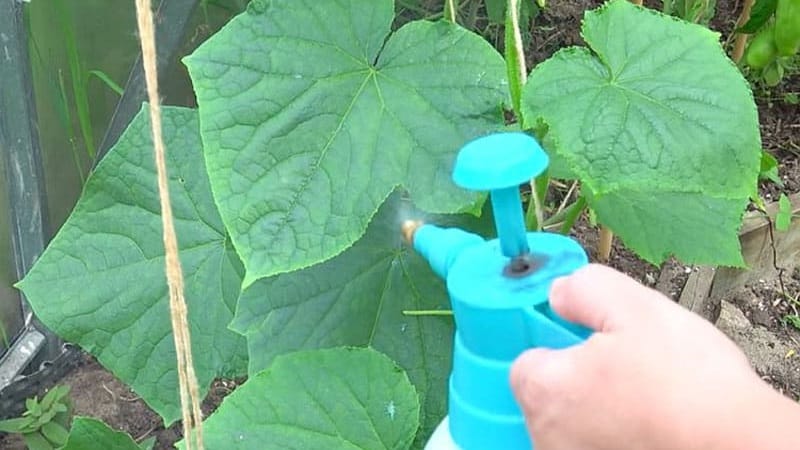
Recipes for solutions
After planting in a permanent place, cucumber seedlings can be fertilized with chemicals no earlier than two weeks later. Before this, the roots must take root and strengthen in the soil - they are not yet able to absorb nutrients. During this period, organic feeding with diluted whey with iodine will help. The best results are obtained with whey not from store-bought milk, but from homemade milk.
For feeding cucumbers
There are many recipes for feeding with iodine-whey solution, the main thing is to observe the proportions of the substances added, choose the right time and method of processing.
With sharp fluctuations in day and night temperatures, cucumber leaves begin to turn yellow. In this case, a folk recipe will help:
- 1 liter of whey;
- 10 liters of water;
- 2 tbsp. l. grated laundry soap;
- 20 drops of iodine.
The resulting mixture is sprayed onto cucumber bushes..
Reference! Laundry soap is added to the solution to create an adhesive mass that creates a thin protective film on the surface of the foliage. Thanks to it, the solution is not immediately washed off from the leaves.
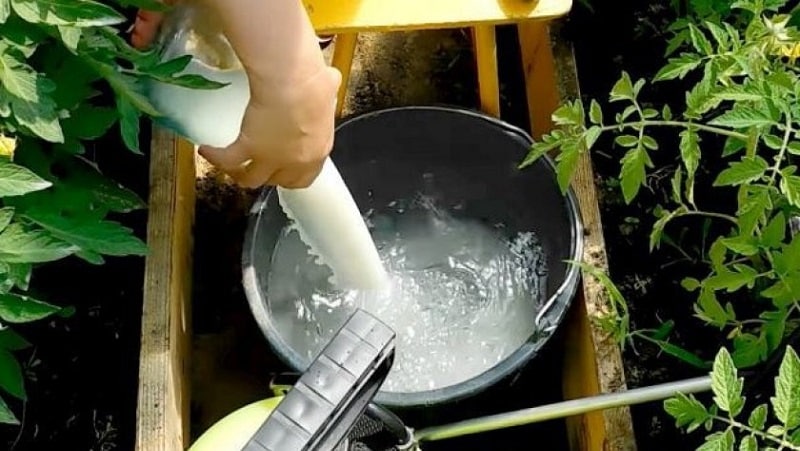
To increase green mass Once every 15 days, water the roots with the following composition:
- water - 5 l;
- iodine - 15 drops;
- whey - 500 ml.
To enhance the nutritional properties of whey, add other components:
- Bird droppings are mixed with wood ash in a bucket, and 1 liter of serum is poured in. 200 g of yeast are diluted in warm water with 1 tbsp. l. sugar is added to the whey mixture. Infuse the mixture for one week. Before feeding the crop, 1 liter of the mixture is diluted in 10 liters of water and 10 drops of iodine are added. 0.5 liters of solution is poured under each bush.
- A mixture of whey, iodine and meadow herbs gives good results. The mixture is left to ferment for a week, diluted with water and watered under the root.
- Fertilizing with the use of fermented milk product, iodine, wood ash and honey is of great benefit. For 1 liter of whey take a glass of wood ash, 3 tbsp. l. honey and 10 drops of iodine, leave to brew for 3-4 days. It is good to treat cucumbers with this mixture during the flowering period - fertilizing prevents the ovary from falling off.
Whey and iodine in combination with other beneficial substances replenish the missing elements necessary for the development of cucumbers and high-quality fruiting. Adding yeast saturates the soil with magnesium and vitamin B. Bird droppings replenish the soil with nitrogen. Herbal infusion nourishes the soil with trace elements and amino acids. As a result of these fertilizing, cucumbers acquire excellent taste.
Read also:
To combat diseases and pests
From caterpillars, aphids, fleas, ticks, flies and other crawling and flying insect pests Traps are placed in cucumber beds. Take small but deep containers, jars, and fill them halfway with serum with iodine. The walls and edges of the container are greased with oil.
In the evening, traps are placed between the cucumber beds. The sour smell attracts insects and slugs that feed on cucumber leaves. Pests enter the containers overnight. On the slippery walls of the trap they have no way to get out. In the morning they are destroyed.
At the first signs of the appearance of late blight, apply the composition:
- whey - 1 l;
- iodine - 30 drops;
- laundry soap - 20 g;
- water - 10 l.
The resulting composition is sprayed once every 10 days.
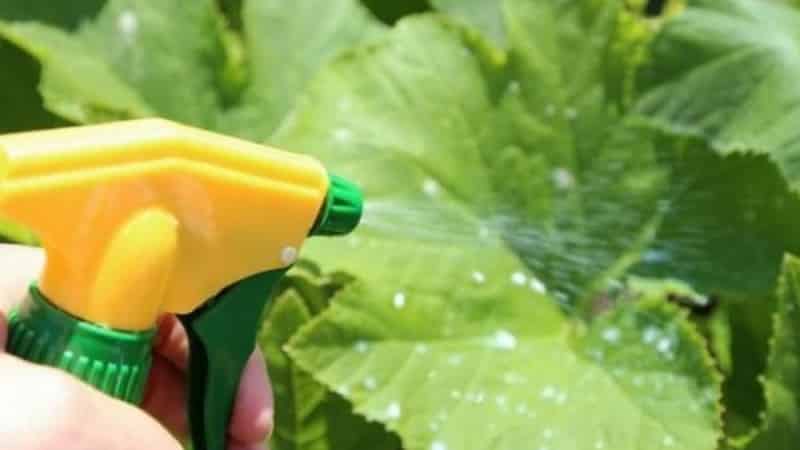
When treating powdery mildew, it is better to use curd whey. To do this, prepare the following composition:
- whey - 0.5 l;
- iodine - 5 drops;
- urea - 20 g;
- water - 2 l.
This option is also effective:
- whey - 2 l;
- copper sulfate - 5 g;
- iodine - 10 drops;
- water - 5 l.
How to water and spray
It is recommended to treat affected bushes in the morning., before the sun begins to strongly warm the earth. The weather should be calm so that the wind does not carry away drops of the solution.The treatment is carried out with a freshly prepared solution using a spray bottle or garden sprayer. You can use a watering can with a nozzle.
Spray the bushes from above, it is important to ensure that the medicinal solution gets to all parts of the plant, including the underside of the leaves.
Watering with the medicinal composition is carried out in the morning or evening hours. To prevent the solution from spreading over the surface of the earth, it is first loosened.
Important processing rules
For prevention purposes, iodine-serum solution for cucumbers, apply no more than three times per season. You cannot spray the bushes with a medicinal composition in the middle of the day in sunny weather - the leaves will get sunburned.
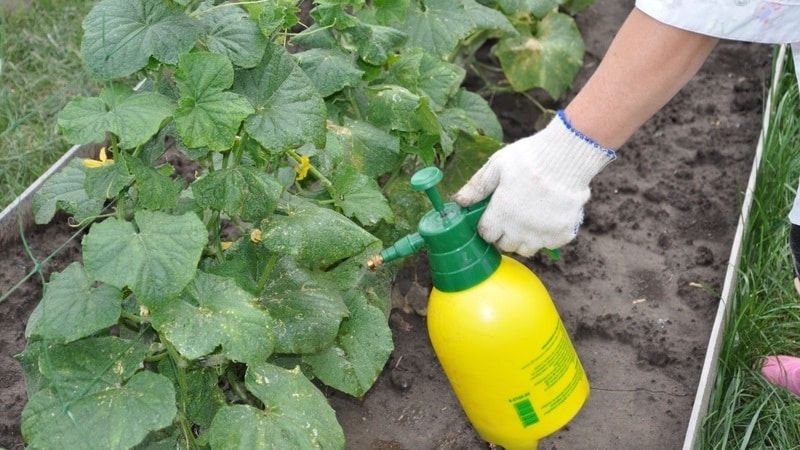
Treatment is carried out at intervals of 10-15 days. It is not recommended to use pure whey; to prepare the composition, it is diluted with warm water. When watering, the solution is poured not at the very root, but at a distance of 30-40 cm from the stem.
Important! For treatments, use a freshly prepared iodine-whey solution. When storing the solution, pathogenic fungi grow in it. For processing, use a fresh product that has not been boiled.
When growing cucumbers in a greenhouse Evening treatment with iodine-whey composition is not recommended. At night, the temperature drops, increased air humidity is created in the greenhouse, and condensation forms on the plants. If you spray with a medicinal composition at this time, this will further increase the air humidity. Such a microclimate will create favorable conditions for the development of pathogenic fungi, root rot, and powdery mildew.
Precautionary measures
When preparing solutions based on whey and iodine, considerthat iodine vapor in large quantities damages the human respiratory tract.In addition, iodine tends to accumulate in fruits, so the dosage of the drug should not be exceeded.
Processing in an open area does not require special protective equipment. In a closed greenhouse, working with a concentrated iodine solution requires respiratory protection. Make sure that iodine does not get on the mucous membranes of the eyes - it causes a burn.
Conclusion
Experienced gardeners have long appreciated the effect of whey in combination with iodine and successfully use it when growing cucumbers. The composition saturates the crop with useful elements, prevents fungal infections, and eliminates the invasion of insect pests. The use of a medicinal composition increases the yield and improves the taste of cucumbers.
“Bird droppings add nitrogen to the soil. Herbal infusion nourishes the soil with trace elements and amino acids. As a result of these fertilizing, cucumbers acquire excellent taste.”
— Yessss, author... cucumbers will acquire an excellent taste :-)))))))))))00